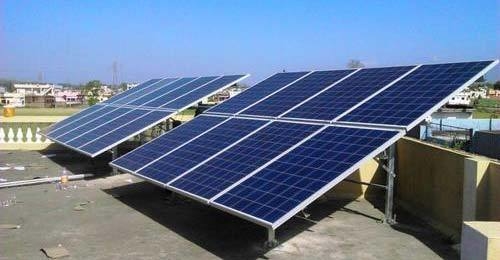India’s Draft Electricity Plan Sees Increase In Solar And Decrease In 2030 Coal Capacity
The revisions seem to exceed commitments made by PM Modi’s at COP26, Glasgow, last year

The Indian government has put out a new draft electricity plan for comments. This is part of their 5 yearly exercise. The draft plan sees about a 24% increase in 2027 solar capacity compared to its previous plan AND a decrease of about 18GW of coal capacity compared to another government report released in 2020.
The revisions seem to exceed commitments made by PM Modi’s at COP26, Glasgow, last year. According to India’s updated NDC, India aims to increase its total share of installed non-fossil capacity to 50% by 2030. However, according to the draft electricity plan, India would have 57% non-fossil capacity by 2027 and 68% non-fossil installed capacity by 2032.
Vibhuti Garg, Energy Economist, IEEFA, says “India’s draft electricity plan shows that India aims to bank on solar for most of its power needs. This is a massive jump, and looking at the double digit growth rate for solar in India for the last 5 years, India’s solar industry looks set to boom. Setting a solar target of 333GW is a clear indication to India’s manufacturing sector to invest in increasing domestic manufacturing capacity.”.
Compared to India’s previous electricity plan released in 2018, India was expected to have 150GW of installed solar capacity by 2027. The draft new electricity plan increases this target by an additional 36GW to 186GW by 2027.
Ashish Fernandes, CEO, Climate Risks Horizon, said “The power sector has already been facing a problem of surplus generating capacity, evidenced by struggling coal plants and RE growth much below targeted levels. Adding new coal will make it impossible for India to achieve the ambitious RE goals laid down by the Prime Minister. It’s time to choose -a financially justifiable energy strategy when RE and battery storage is cheaper, faster and cleaner. The plan acts as a guiding document for any power sector capacity expansion. The new plan sees a significant increase in solar targets for 2027 compared to an earlier plan. The increase is about 24%. Wind and coal capacity for 2030 sees a downward revision. when compared to Central Electricity Authority’s Optimal Generation Capacity Mix report that was released in 2020”.
According to Ember’s Electricity Data Explorer, India’s renewable energy capacity has grown at an average growth rate of 19% annually between 2016 to 2021. India increased its installed solar capacity by an average growth rate of 47% annually between 2016 – 2021. Compared to double digit growth in solar power capacity expansion, wind power saw a single digit growth rate of 7% during the same period. Although India has seen a double digit increase in its renewable energy capacity increase in recent years, India has not been able to meet its 2022 target of 175GW of installed RE capacity. Its current installed solar and wind capacity stands at 90GW.
Highlights of the Draft National Electricity Plan, 2022
● Solar energy targets for 2026-27 have seen significant increase compared to NEP2018. NEP2018 forecasted installed solar capacity to be 150GW by 2027. The draft NEP2022 revises 2027 installed solar capacity to 186GW, an increase of 24%.
● According to NEP2018, installed wind capacity targets for 2027 was 100GW. The draft NEP2022 decreases this target to 80GW for wind, a decrease of 20%
● Draft NEP2022 estimates Solar and wind energy targets for 2031-32 to be 333GW and 133GW respectively. Compared to 2029-2030 estimates of CEA’s Optimal Generation Capacity Mix 2029-2030 (OGC) report, this is an increase of 18% for solar and decrease of 5% for wind. ● Draft NEP2022 also sees an increase in battery storage from 27GW of 4 hour storage estimated in the OGC report to 51GW of 5 hour storage 2031-32.
● New draft National Electricity Plan 2022 (NEP2022) sees about 18GW reduction in coal capacity by 2030 when compared to the OGC report released in 2020. The new draft also corrects its 2027 estimates for installed coal capacity by about 1GW compared to the earlier NEP released in 2018 (NEP2018).
● According to the draft NEP2022, beside the under construction coal-based capacity of 25GW, there will be an additional 17 GW to around 28 GW coal based capacity which will be required till 2031-32.
● Contribution from coal to the power mix is expected to fall from 70% today to 59% by 2026-2027 and 50% by 2031-2032.
● The draft NEP2022 revised peak demand from 298.7GW to 270GW for 2027. This downward revision is normal and consistent with earlier CEA reports. All India peak demand in 2030 is forecasted to be around 363GW for 2031-32, this is about 9% higher compared to what was forecasted in the OGC report.
● DraftNEP2022 proposes the retirement for period 2022-27 as 4629 MW, which includes the decommissioning of coal-based capacity due to lack of plans for FGD installation. Further no coal or gas-based capacity has been considered for retirement during the period of FY 2027-32. This is a significantly lower retirement rate as compared to what was proposed in the OGC – which looked at a retirement of old coal based units totaling to 25,252 MW for the time period 2022-30. A total of 10044.295 MW coal based capacity has been retired between 2017-22.
The writer of this article is Dr. Seema Javed, a known Environmentalist, Journalist and Communications Expert




